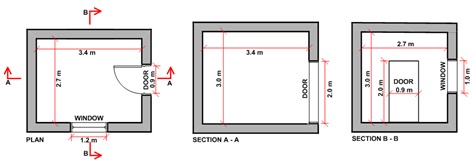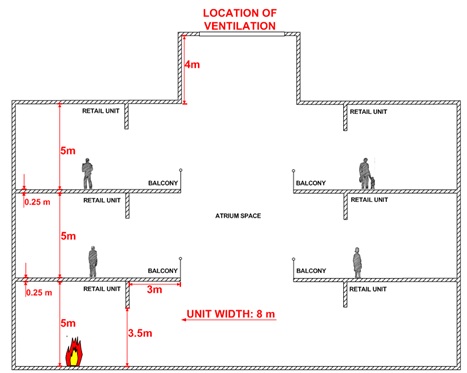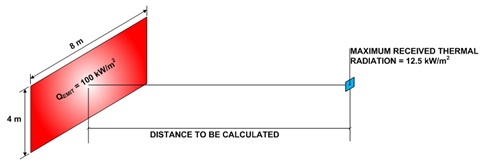Assignment:
QUESTION 1
A steel square tray (1.25 m x 1.25 m x 0.1 m) is filled with kerosene and ignited. Compute the following:
1. 1(a) The heat release rate.
2. 1(b) The flame height.
3. 1(c) The duration of burning.
A compartment is introduced as shown in Figure below: Question 1 below.
4. 1(d) What is the theoretical maximum het release rate that can be attained within the compartment? (Hint: in a fire, for each kg of oxygen consumed, 13,100 kJ of energy is released).
5. 1(e) Using the Babruaskas method, what is the minimum heat release for a fire to cause flashover in the compartment?
6. 1(f) Using the Thomas method, what is the minimum heat release for a fire to cause flashover in the compartment? (Assume door fully open and window fully broken).
The kerosene fire is placed in the centre of the compartment shown in Figure below: Question 1.
7. 1(g) Assuming the compartment is comprised of 150 mm thick concrete, calculate the time temperature history for the kerosene fire in the compartment (see slide 136 for thermal properties).
8. 1(h) Assuming the compartment is comprised of 150 mm thick gypsum board, calculate the time temperature history for the kerosene fire in the compartment.
9. 1(i) Present results attained in Parts 1(g) and 1(h) of this question in graphical format and provide commentary.

QUESTION 2
Figure: Question 2 is a section through a 3 storey shopping centre, incorporating an atrium. At each unit opening a deep downstand is present, with a higher projecting balcony prefacing the atrium space.
Design a smoke and heat exhaust system for the building achieving the following tenability criteria:
• Smoke layer to stabilise at minimum of 2.5 m above top most level (i.e 2ndfloor level)
• Smoke layer temperature not to exceed 200oC
Assume the following.
All retail units are provided with quick response sprinklers, resulting in:
• Fire perimeter: 5 m
• Convective heat flux entering atrium space: 2500 kW
Hint: Where smoke and heat from a fire in a unit enters the atrium space:
• fire in a ground floor unit will result in greatest amount of smoke,
• fire in a 2ndfloor unit will result in the greatest temperature.

QUESTION 3
1. 3(a) Briefly discuss how heat transfer by radiation dictates the progression of a typical compartment room fire.
2. 3(b) Figure: Question 3 shows a panel emitting a radiant heat intensity of 100 kW/m2. A receiver is located a distance normal (and dead centre) to the radiant panel and is receiving a radiant heat intensity of 12.5 kW/m2. Calculate the distance between the radiant panel and the receiver.
